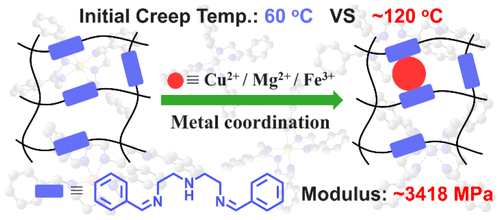当前位置:
X-MOL 学术
›
Macromolecules
›
论文详情
Our official English website, www.x-mol.net, welcomes your
feedback! (Note: you will need to create a separate account there.)
Facile Preparation of Polyimine Vitrimers with Enhanced Creep Resistance and Thermal and Mechanical Properties via Metal Coordination
Macromolecules ( IF 5.1 ) Pub Date : 2020-04-09 , DOI: 10.1021/acs.macromol.0c00036 Sheng Wang 1, 2 , Songqi Ma 1 , Qiong Li 1, 2 , Xiwei Xu 1 , Binbo Wang 1 , Kaifeng Huang 1 , Yanlin liu 1 , Jin Zhu 1
Macromolecules ( IF 5.1 ) Pub Date : 2020-04-09 , DOI: 10.1021/acs.macromol.0c00036 Sheng Wang 1, 2 , Songqi Ma 1 , Qiong Li 1, 2 , Xiwei Xu 1 , Binbo Wang 1 , Kaifeng Huang 1 , Yanlin liu 1 , Jin Zhu 1
Affiliation

|
Vitrimers undergoing dynamic bond exchange enable reprocessing and recycle of thermosets. However, vitrimers are susceptible to creep, leading to their poor dimensional stability, which limits their applications. Here, a facile method via integration of metal complexes was utilized to address this issue, and cross-linked polyimine was selected as an example of vitrimer. Three different metal complexes were introduced into a polyimine vitrimer via a one-pot preparation involving the formation of metal complexes and cross-linking of polyimine. The addition of 0.5 mol % Cu2+ relative to imine bond reduced creep degree from 30% to 20% at 60 °C, and the creep resistance was enhanced with increasing Cu2+ content. Loading 5 mol % Cu2+ increased the initial creep temperature from 60 to about 100 °C and raised the Arrhenius activation energy (Ea) for stress relaxation from 52.3 to 67.7 kJ mol–1. The ability of different metal complexes to suppress creep followed the order of Fe3+ > Cu2+ > Mg2+, and the initial creep temperature reached around 120 °C for vitrimer with 5 mol % of Fe3+. Meanwhile, the polyimine–metal complex vitrimers still exhibited excellent reprocessing recyclability. Moreover, the introduction of coordination structures enhanced the thermal and mechanical properties, solvent, and acid resistance. Thus, metal coordination is an efficient approach to achieve high-temperature creep resistance, excellent thermal and mechanical properties, and chemical stability for vitrimers based on the Schiff base.
中文翻译:

通过金属配位轻松制备具有增强的抗蠕变性以及热和机械性能的聚亚胺三聚体
进行动态键交换的三聚体使热固性塑料能够进行再加工和回收。然而,微晶硅易于蠕变,导致其差的尺寸稳定性,这限制了它们的应用。在这里,通过整合金属络合物的简便方法来解决这个问题,并选择了交联聚亚胺作为玻璃体的例子。通过一锅法制备将三种不同的金属络合物引入到聚亚胺三聚体中,该制备涉及金属络合物的形成和聚亚胺的交联。相对于亚胺键,添加0.5mol%的Cu 2+可以将60℃下的蠕变度从30%降低到20%,并且随着Cu 2+含量的增加,抗蠕变性提高。负载5 mol%Cu 2+将初始蠕变温度从60提高到约100°C,并将应力释放的阿伦尼乌斯活化能(E a)从52.3 kJ mol –1提高到67.7 kJ mol –1。不同金属络合物抑制蠕变的能力遵循Fe 3+ > Cu 2+ > Mg 2+的顺序,对于含5 mol%Fe 3+的玻璃化剂,初始蠕变温度达到120°C左右。。同时,聚亚胺-金属络合物微粉仍显示出极好的后处理可回收性。此外,配位结构的引入增强了热和机械性能,耐溶剂性和耐酸性。因此,金属配位是一种有效的方法,可实现基于Schiff碱的微晶陶瓷的高温抗蠕变性,出色的热和机械性能以及化学稳定性。
更新日期:2020-04-09
中文翻译:

通过金属配位轻松制备具有增强的抗蠕变性以及热和机械性能的聚亚胺三聚体
进行动态键交换的三聚体使热固性塑料能够进行再加工和回收。然而,微晶硅易于蠕变,导致其差的尺寸稳定性,这限制了它们的应用。在这里,通过整合金属络合物的简便方法来解决这个问题,并选择了交联聚亚胺作为玻璃体的例子。通过一锅法制备将三种不同的金属络合物引入到聚亚胺三聚体中,该制备涉及金属络合物的形成和聚亚胺的交联。相对于亚胺键,添加0.5mol%的Cu 2+可以将60℃下的蠕变度从30%降低到20%,并且随着Cu 2+含量的增加,抗蠕变性提高。负载5 mol%Cu 2+将初始蠕变温度从60提高到约100°C,并将应力释放的阿伦尼乌斯活化能(E a)从52.3 kJ mol –1提高到67.7 kJ mol –1。不同金属络合物抑制蠕变的能力遵循Fe 3+ > Cu 2+ > Mg 2+的顺序,对于含5 mol%Fe 3+的玻璃化剂,初始蠕变温度达到120°C左右。。同时,聚亚胺-金属络合物微粉仍显示出极好的后处理可回收性。此外,配位结构的引入增强了热和机械性能,耐溶剂性和耐酸性。因此,金属配位是一种有效的方法,可实现基于Schiff碱的微晶陶瓷的高温抗蠕变性,出色的热和机械性能以及化学稳定性。





















































 京公网安备 11010802027423号
京公网安备 11010802027423号